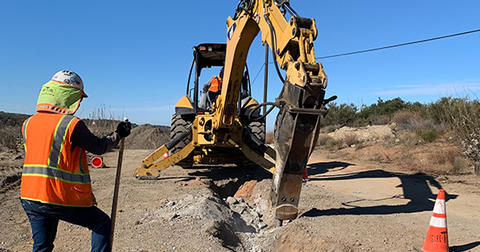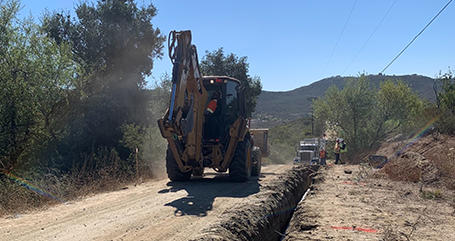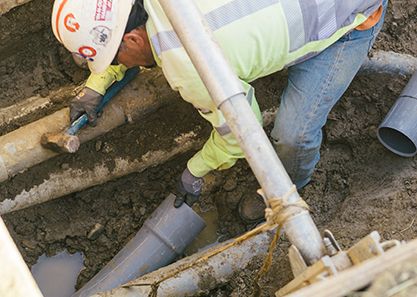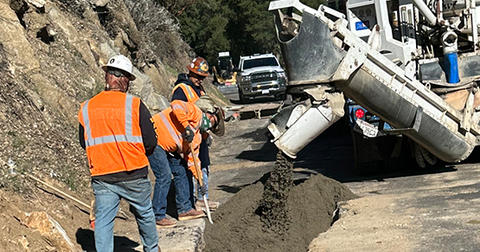Strategic Undergrounding Program
As part of our ongoing strategy to reduce wildfire risk and the impact of Public Safety Power Shutoffs (PSPS) during adverse weather conditions, San Diego Gas & Electric (SDG&E) is moving overhead power lines underground in areas at most risk for wildfires and PSPS. This is known as Strategic Undergrounding.


Overview
Strategic undergrounding is one of several projects in SDG&E’s Wildfire Mitigation Plan that aims to significantly reduce the chances of a utility-related wildfire. The program also helps reduce PSPS impacts on important facilities like schools, libraries, medical centers and fire stations.
Over the past decade, we’ve implemented, and continue to improve, our comprehensive wildfire risk mitigation program. This includes significant investments to:
- Replace wood poles with fire-resistant steel poles and including covered conductors
- Building a sophisticated weather monitoring network
- Updating fire and weather forecast models’ operating protocols
- Building partnerships to enhance the region’s overall ability to respond to wildfires
About the Project
The Strategic Undergrounding Program will provide heightened wildfire resiliency and electric reliability by undergrounding electric distribution lines near key community facilities. Removing overhead power lines and placing them underground helps remove the risk of sparking fires during adverse weather. It also enables the power lines to remain energized during PSPS which reduces the impact of power outages on fire-prone communities.
After individual circuits or projects are undergrounded, the SDG&E overhead power lines and equipment will be removed, but what is left may vary on the powerline configuration. For example, if poles are also used by other utility providers, such as telephone or cable, and are required by those service providers, then the poles will remain to support those services.
Work on the Strategic Undergrounding Program began in 2019 and is anticipated to continue through the end of 2032. The goal is to underground approximately 1,500 miles of powerlines.


Project Benefits
- Significantly reduced wildfire risk and PSPS during adverse weather conditions
- Increased resiliency and reliability of the electric system serving your community
- Communities and critical facilities can remain energized during severe weather conditions and PSPS events
Construction Details
While our goal is to complete the project as quickly as possible to minimize impact on the community, weather and other unforeseen factors could affect the construction schedule. There will be multiple construction locations and activities taking place at the same time. Work hours, traffic control measures and noise restrictions for each area are imposed by the local authorities.
Planned construction hours are Monday through Saturday, 7 a.m. to 7 p.m., depending on the project’s approved permits and needs. Motorists and residents can expect intermittent traffic delays in the affected areas during construction hours.
Your patience is appreciated as we work to build a safer, more reliable energy grid for the future.


2025 Wildfire Mitigation Plan
Frequently Asked Questions
Browse our FAQs below or view the pdf.
SDG&E’s Strategic Undergrounding Program is part of our Wildfire Mitigation Plan and aims to significantly reduce the risk of wildfires caused by electrical equipment and the need for Public Safety Power Shutoffs (PSPS) by moving overhead power lines underground. SDG&E® generally prioritizes undergrounding projects in areas of the region that are at the most risk for wildfires and PSPS.
Each property is different, so construction plans will vary. SDG&E’s design and engineering firms will work with each customer on a specific construction plan unique to their property. Construction work will include trenching and installation of new underground cable. A new service panel may also be required to connect to the new underground electrical service. SDG&E crews and our contractors will strive to minimize construction impacts as much as possible for each customer. Crews will also make every effort to safely install the new underground system and minimize any environmental impacts while also avoiding existing utilities. We work closely with design, construction, and environmental experts to ensure we are respecting environmentally sensitive areas and any other site-specific concerns.
SDG&E prioritizes undergrounding on power lines in areas it considers to have the highest wildfire risk. Each power line undergrounding project is different. The timing of construction on or near your property will depend on local digging conditions, acquisition of right-of-way, as well as local, state, and federal permits and environmental constraints. In addition to an initial survey, SDG&E will send several notifications to affected customers, including letters 90 days and 30 days before the work begins to update you as construction approaches. A “Permission to Enter” (PTE) form will also be included in these letters, which is required for any undergrounding work to be completed on private property.
By signing a PTE, you allow SDG&E to connect and convert your individual service and meter panel to the new underground system. If you receive a PTE form in the mail, we kindly ask that you please return it at your earliest convenience.
The goal of the Strategic Undergrounding Program is to remove SDG&E overhead equipment, including power lines and related infrastructure, to reduce the risk of ignitions caused by electrical infrastructure and the need for PSPS events. SDG&E’s existing overhead power lines and equipment may eventually be removed once the undergrounding project is complete, but what is left may vary depending on the power line configuration. For example, if poles are also used by other utility providers, such as telephone or cable, and are required by those service providers, then the poles may need to stay for those services.
Our crews and contractors will perform the work as expeditiously as possible at your property at no direct cost to you. If a customer requests individual upgrades that are not in the project scope, such as meter panel upgrades or relocations, the customer will be responsible for those upgrades and costs.
Yes. Prior to the start of the undergrounding project, our design and engineering firms will inspect the planned route of the underground power line for planning purposes. Once construction is complete, the width of the trench will be repaved to match the grade of the road and will adhere to the requirements of local permits.
Depending on the location of your meter, your driveway may temporarily be inaccessible during construction. Our crews will notify you should your access be impacted. Traffic control personnel will be on-site to ensure that you will be able to travel freely. Our crews and contractors will perform the work as safely and expeditiously as possible at your property to minimize any temporary inconvenience.
Strategically placing our infrastructure and power lines underground in our service territory significantly reduces the risk of wildfires caused by electrical infrastructure, the need for Public Safety Power Shutoffs in those areas and promotes additional service reliability. Refusing to allow for the undergrounding of the electric system could create an unnecessary island of ignition risk for your home and community and result in continued PSPS impacts. We also understand the inconvenience this work may cause. Our design consultants will work with each customer on the details of this upgrade and will be available for any questions. We appreciate our customers’ time and flexibility as we do this critical work in the most efficient way possible to reduce wildfire risk and keep your home and community safe.
For more information
If you have questions, please call the Project information Line at 1-844-765-6388.